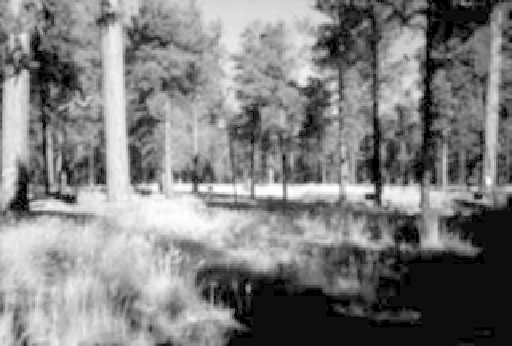Environmental Engineering Reference
In-Depth Information
FIGURE 12.2
Same permanent photo point from Pearson Natural Area Ecological Restoration Study Area, 1997. Four years
after thinning to 60 trees per acre, raking and prescribed burning, there was 6 tons per acre of fuel and 400
lb per acre of herbaceous production, thus effectively moving the fuel load from the trees and shrubs to the
ground layer where fires burn cooler and are more easily controlled. (From Covington, W.W.,
Ecol. Restor.
, 21, 7,
2003. Copyright by the Board of Regents of the University of Wisconsin System. Reproduced by the permission
of the University of Wisconsin Press.)
order to preserve and enhance critical habitat for humans, other animals, and plants.
In dealing with the forests of the American West, restorationists need to think about
landscapes that typically cover 100,000-1,000,000 ac—large pieces of land that include not
only wildlands but also human communities.
For those living in the urban-wildland zone, the evidence seems pretty clear. They can
protect their properties by building with fire-resistant materials, planting fire-resistant
landscapes, thinning excess trees close to their homes, and avoiding building in or near
forest sites with high fuel loads.
12.4.3 Benefits and Challenges of Restoring Western Dry Forests
The benefits of restoring the dry western forests are many; the challenges are great.
The benefits include: (1) improved watershed function and sustainability; (2) enhanced
native plant and animal biodiversity, including threatened and endangered species; (3)
elimination of unnatural forest insect and disease outbreaks; (4) enhanced natural beauty
of the land; (5) improved resource values for humans, now and into the future; and (6)
economic benefits from jobs and goods created by restoration activities.
Several things could hamper restoration efforts, not the least of which is short-term
thinking. Specifically, we know that the restoration of these forests will be expensive in
the short term, although its benefits will accrue as time progresses. Counterproductive,
position-based negotiating stances employed by some are now standing in the way of
moving forward with implementing restoration treatments. This kind of situation results
in political maneuvering about setting iron-clad management prescriptions, such as
one-size-fits-all diameter caps, that can interfere with cost-effective, ecologically sound
restoration efforts. Finally, restoration efforts will be hampered if we fail to make sure that
trees are being removed principally for the purpose of restoring natural forest patterns
and processes, not economic gain.


Search WWH ::

Custom Search